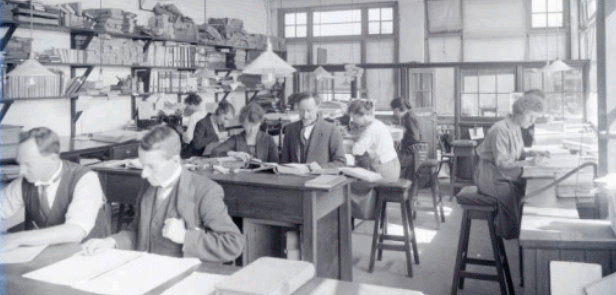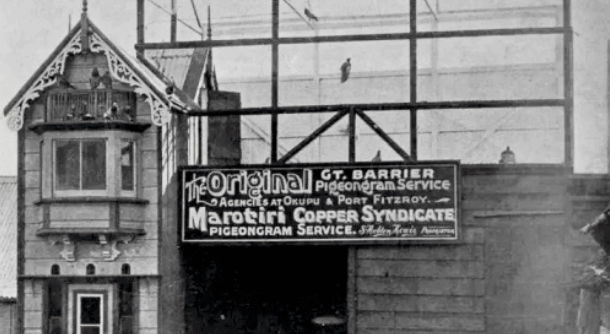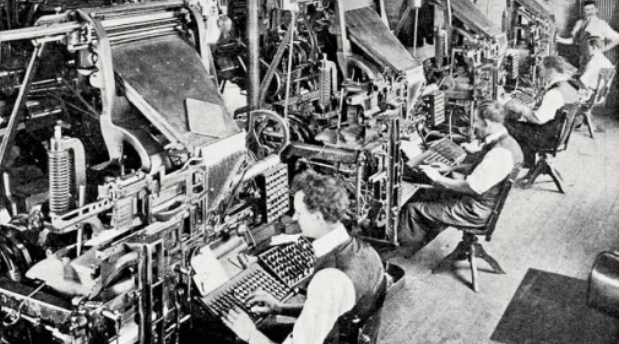A Paeroa ‘Men’s Magazine’ was one of many Thames Valley publications to appear in the district over the years. Although its title was eyebrow raising, it was little more than an innocent endeavour in 1933 by the men in the relief camp for unemployed workers on the Paeroa racecourse.
Named the Pick and Shovel it was breezily written by contributors featuring stories mainly about themselves. Copies could be purchased by the public at the relief workers’ boot repairing depot opposite the Criterion Hotel.
The first newspaper in Paeroa – the Hauraki Tribune – was first published in 1885, later being swallowed up in 1896 by its rival the Ohinemuri Gazette, which was established in 1891.
When the Gazette office was destroyed by fire in 1908, only a little printing paper and a few miscellaneous articles were rescued.
Undaunted, the Gazette said “The fire in our premises will necessarily disorganise our business to a great extent, but we are making arrangements to publish as usual.” The proprietor of Waihī’s newspaper placed his extensive printing plant at their disposal.
In 1921 the Ohinemuri Gazette changed its name to the Hauraki Plains Gazette, was incorporated into the Thames Valley Gazette in 1977, along with two other local newspapers, becoming the Paeroa Gazette in 1988. This merged with the Thames Star in 1998 to become the Thames Valley Gazette, but the new publication lasted less than a year. In the early 1990s, the Plains Profile, manned by dedicated community volunteers, began its 30-odd year run bringing the news to the Hauraki Plains district. It was bought by Teresa Ramsey in 2020, renamed The Valley Profile and expanded to include Paeroa, Thames, Thames Coast, Waihī and the Coromandel Peninsula.

om, an anxious wait for a speck in the sky was the lot of newspaper reporters between Auckland and Thames when pigeons brought news written on flimsy paper tied securely to their legs. These ‘pigeongrams’ sometimes only arrived five minutes before press time and reporters who were competent in every other way were at a loss when it came to the birds, making endearing noises while trying to steer the elusive messengers towards them with pieces of stick.
The Thames Advertiser and Miner’s News, Thames’ first newspaper, was established in 1868, being printed in Willoughby St near the beach. After the proprietors of the Thames Advertiser parted ways, one of them started a new paper – The Thames Guardian and Mining Record. This lasted only a few months, folding in 1872. The Thames Advertiser also had its challenges including employees like Mr Riddle, a compositor whose job entailed assembling movable type and blocks to form pages for printing, who went on strike in protest at the employment of female labour on the paper. The Thames Advertiser had a variety of owners and was published until 1912, when it was merged with the Thames Star.
The second Thames paper was the Times and Thames Miner’s Advocate established in late 1868 by William Shaw and published from Willoughby St.
It was considered a well printed and good literary newspaper, and the editor a very brilliant writer. It was predicted to give the Thames Advertiser a run for its money but by 1870 was no more.
William Shaw also established three or four more Thames newspapers – among them the Thames Times, Weekly Leader, and Thames Evening Star – but by 1870 most of them were defunct and the proprietor bankrupt.

“Journalism rarely dies,” noted an Auckland paper regarding Thames publications, “and when one newspaper has been extinguished, Phoenix-like another springs from its ashes”.
The Mail, an evening penny paper, now appeared from the office of the Thames Advertiser, and was owned by the same proprietors, Corlett and Wilkinson. It was not large but contained a fair amount of general news and thoroughly readable matter.
William Shaw’s Thames Evening Star was taken over by new proprietors and in 1893 became known as The Thames Star. In 1912, The Thames Star absorbed the Thames Advertiser. The Thames Star was thrown back into the past in 1928 when a storm damaged transmission lines and took out the power.
With the greatest of difficulty, it still published its daily issue which featured several different styles of typeface, announcing it was quite an achievement to be able to produce any sort of paper at all in the conditions that prevailed. The Thames Star eventually merged with the Paeroa Gazette in 1998 to become the short-lived Thames Valley Gazette.
Lasting longer was the Waihī Daily Telegraph, despite its proprietor, Mr McRobie, during a bitter miners’ strike in 1912, receiving the following letter – “You dirty black-rimmed-whiskered mongrel; if you don’t alter your hostile tactics towards the Waihī Miners’ Union in your leading articles of your dirty guttersnipe rag, I inform you candidly I have 250 plugs of gelignite, 100 detonators, and six coils of fuse, which you shall swallow if you keep at the rate you are going. Now, McRobie, I have warned you, so beware. I am in earnest. – Only a Striker”.
The Waihī Daily Telegraph, a committed supporter of the mining industry, began life as the Waihī Miner and Hauraki Goldfields Gazette in the mid-1890s. In 1900, the Waihī Chronicle became a daily competitor but only lasted until March 1901. Three days later, the Waihī Miner and Hauraki Goldfields Gazette, now renamed the Waihī Daily Telegraph, released its first issue touted as an up-to-date, one penny evening daily.

From 1906, there was competition from the Waihī Times but by 1908 this had gone bust. The Waihī Daily Telegraph ran until 1951, stopping publication shortly after the Waihī Gazette set up in opposition. In 1986, Independent Newspapers Ltd acquired the Waihī Gazette as well as the Thames Valley Gazette, which folded in 1999. The Waihī Leader, started in 1981, merged with the Coastal News during the Covid-19 pandemic, and was re-launched as the Hauraki-Coromandel Post.
The Hauraki Herald, established in 1979, was one of the district’s longest running papers, publishing for 45 years.
Through all their incarnations, local newspapers continued to document the life of their communities.
“The Cinderella of a town’s activities can aptly be termed the local newspaper, nicknamed, laughed at, scorned, yet read from front to back and conveying to the public a wealth of information both desirable and necessary in the business and social activities of the town and district it serves,” reflected the Hauraki Plains Gazette in 1937.
The ‘local rag’ also recorded the ebb and flow of life through its births, marriages and deaths columns and provided an outlet for public opinion to be voiced.
Very little stopped the presses rolling for long, even when a paper boy was caught in the printing machinery of the Thames Star in 1957.
While a doctor attended to him, mechanics used an acetylene torch to cut the boy free. After the press had been repaired, more papers were printed.




